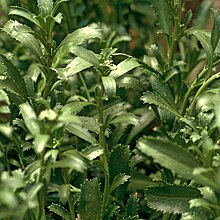Lepidium banksii
| Lepidium banksii | |
|---|---|

| |
| Coastal peppercress | |
| Scientific classification | |
| Kingdom: | |
| (unranked): | |
| (unranked): | |
| (unranked): | |
| Order: | |
| Family: | |
| Genus: | |
| Species: | L. banksii
|
| Binomial name | |
| Lepidium banksii | |
| Synonyms[3] | |
|
Lepidium forsteri | |
Lepidium banksii, known as coastal peppercress, is a rare species of flowering plant from the Brassicaceae family. It is endemic to New Zealand, formerly found around the coast of the northern South Island but now critically endangered.[4][5]
Discovery and description
Coastal peppercress was first collected for culinary purposes: by Cook, in 1770 in the Marlborough Sounds, along with its relative Lepidium oleraceum, as a treatment for scurvy. Both species are members of the Brassicaceae or cabbage family and contain vitamin C.[6] It was collected again in 1827 by Dumont d'Urville in Queen Charlotte Sound and Astrolabe Harbour, and from those specimens was described by Thomas Kirk in 1899[7] and named after Sir Joseph Banks, the naturalist on Cook's first voyage.[3]
Distribution
L. banksii is strictly coastal, growing in coastal boulders and on shell banks in estuaries. Formerly it was found in the northern South Island, from Karamea on the West Coast to Tasman and Golden Bays and the Marlborough Sounds. More recently, it has been recorded from just two localities: the Waimea Estuary near Nelson, and north of Totoranui in Abel Tasman National Park.[3]
Conservation
L. banksii is functionally extinct in the wild: there are no naturally occurring plants remaining, and its population is dependent on cultivation and planting or seed-sowing.[4]
References
- ^ de Lange PJ, Norton DA, Courtney SP, Heenan PB, Barkla JW, Cameron EK, Hitchmough R, Townsend AJ (2009) Threatened and uncommon plants. New Zealand Journal of Botany 47: 61–96. doi: 10.1080/00288250909509794
- ^ "Lepidium banksii Kirk". www.theplantlist.org. The Plant List. Retrieved 18 May 2016.
- ^ a b c de Lange, P.J. (21 August 2013). "Lepidium banksii". New Zealand Plant Conservation Network. Retrieved 18 May 2016.
- ^ a b de Lange, Peter; Heenan, Peter; Houliston, Gary; Rolfe, Jeremy; Mitchell, Anthony (17 June 2013). "New Lepidium (Brassicaceae) from New Zealand". PhytoKeys. 24: 1–147. doi:10.3897/phytokeys.24.4375. Retrieved 18 May 2016.
{{cite journal}}: CS1 maint: unflagged free DOI (link) - ^ Gee, Samantha (17 May 2016). "Dunedin climate could be key to survival of critically endangered Nelson plant". Fairfax Media Digital. Nelson Evening Mail. Retrieved 18 May 2016.
- ^ Phillips, Vanessa (20 March 2009). "Defying a 'death wish'". Nelson Mail. Retrieved 18 May 2016.
- ^ Kirk, Thomas (1899). The students' flora of New Zealand and the outlying islands. Wellington, New Zealand: John Mackay. p. 35. doi:10.5962/bhl.title.54373. Retrieved 18 May 2016.
External links
- Lepidium banksii on RNZ Critter of the Week, 20 May 2016

